Healthcare Leadership: Improving Performance with Change Theory
VerifiedAdded on 2023/03/31
|13
|3165
|197
Essay
AI Summary
This essay critically examines the role of leadership in facilitating a performance improvement strategy within the health sector, specifically focusing on reducing infection rates. It emphasizes the importance of leadership in meeting organizational goals and creating a flexible workplace that embraces change. The essay explores transformational leadership, highlighting its key aspects such as idealized influence, inspirational motivation, individualized consideration, and intellectual stimulation, and discusses how it can be implemented to reduce infection rates in healthcare. It also delves into Kotter's 8-step change theory, explaining its necessity in guiding organizational change within the healthcare context, and how workplace culture influences healthcare performance.
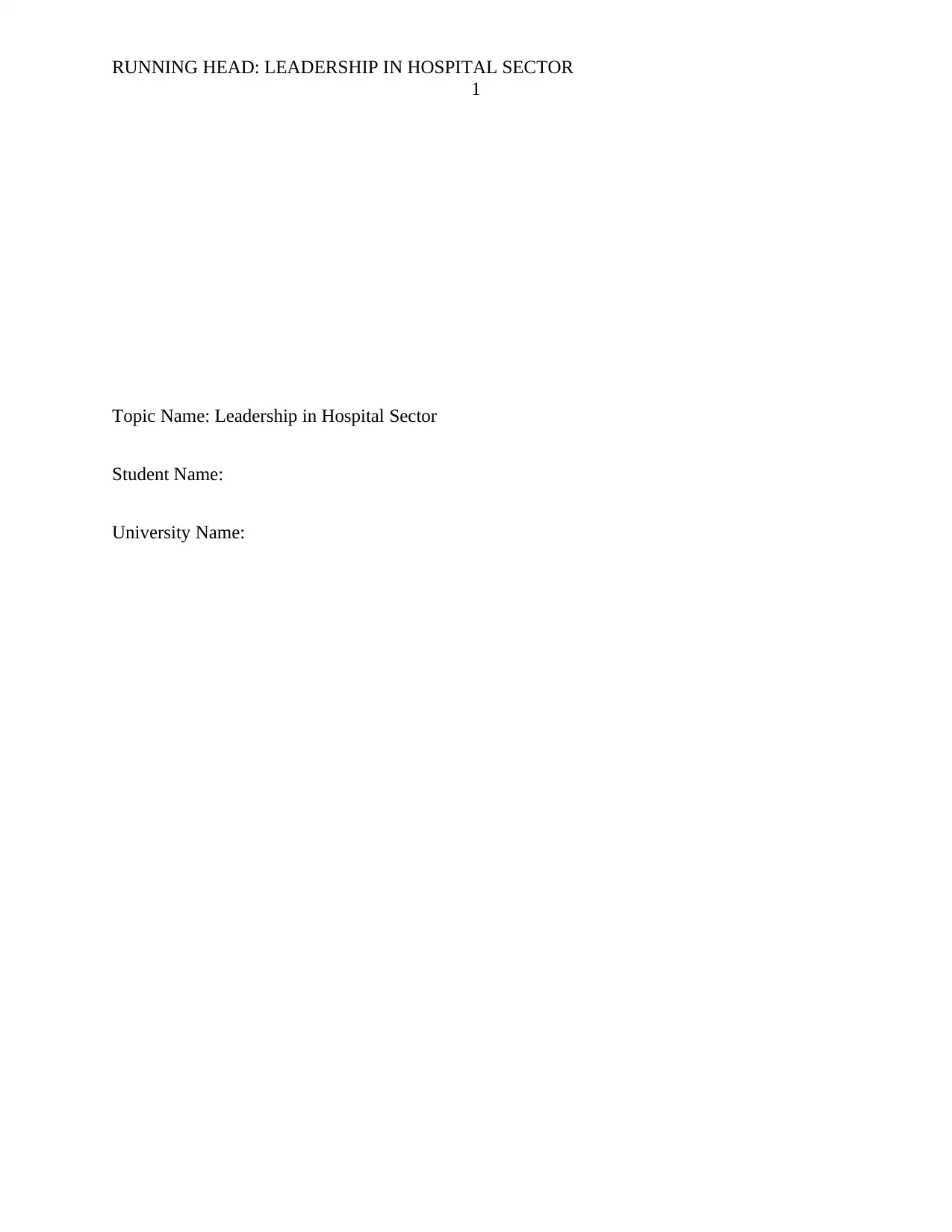
RUNNING HEAD: LEADERSHIP IN HOSPITAL SECTOR
1
Topic Name: Leadership in Hospital Sector
Student Name:
University Name:
1
Topic Name: Leadership in Hospital Sector
Student Name:
University Name:
Paraphrase This Document
Need a fresh take? Get an instant paraphrase of this document with our AI Paraphraser
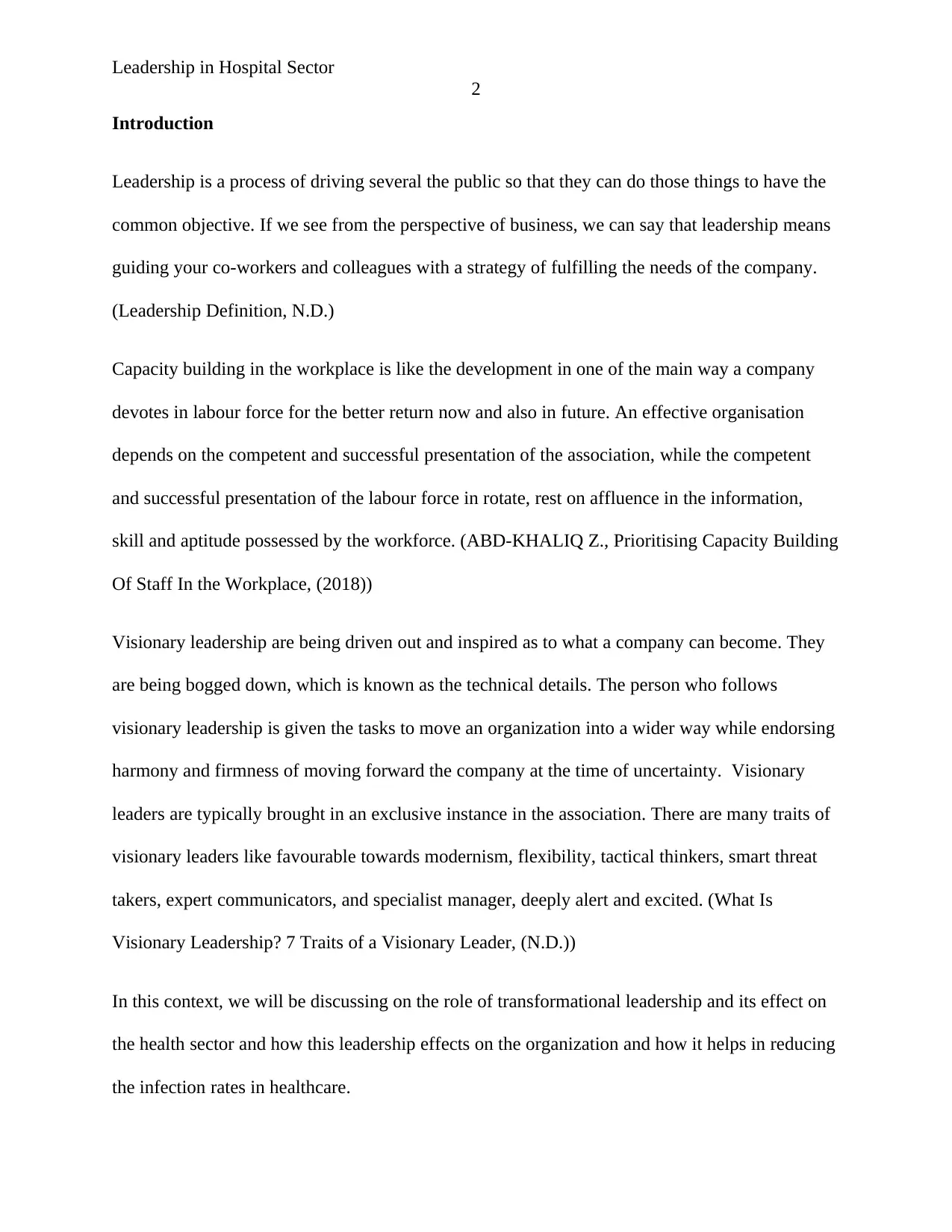
Leadership in Hospital Sector
2
Introduction
Leadership is a process of driving several the public so that they can do those things to have the
common objective. If we see from the perspective of business, we can say that leadership means
guiding your co-workers and colleagues with a strategy of fulfilling the needs of the company.
(Leadership Definition, N.D.)
Capacity building in the workplace is like the development in one of the main way a company
devotes in labour force for the better return now and also in future. An effective organisation
depends on the competent and successful presentation of the association, while the competent
and successful presentation of the labour force in rotate, rest on affluence in the information,
skill and aptitude possessed by the workforce. (ABD-KHALIQ Z., Prioritising Capacity Building
Of Staff In the Workplace, (2018))
Visionary leadership are being driven out and inspired as to what a company can become. They
are being bogged down, which is known as the technical details. The person who follows
visionary leadership is given the tasks to move an organization into a wider way while endorsing
harmony and firmness of moving forward the company at the time of uncertainty. Visionary
leaders are typically brought in an exclusive instance in the association. There are many traits of
visionary leaders like favourable towards modernism, flexibility, tactical thinkers, smart threat
takers, expert communicators, and specialist manager, deeply alert and excited. (What Is
Visionary Leadership? 7 Traits of a Visionary Leader, (N.D.))
In this context, we will be discussing on the role of transformational leadership and its effect on
the health sector and how this leadership effects on the organization and how it helps in reducing
the infection rates in healthcare.
2
Introduction
Leadership is a process of driving several the public so that they can do those things to have the
common objective. If we see from the perspective of business, we can say that leadership means
guiding your co-workers and colleagues with a strategy of fulfilling the needs of the company.
(Leadership Definition, N.D.)
Capacity building in the workplace is like the development in one of the main way a company
devotes in labour force for the better return now and also in future. An effective organisation
depends on the competent and successful presentation of the association, while the competent
and successful presentation of the labour force in rotate, rest on affluence in the information,
skill and aptitude possessed by the workforce. (ABD-KHALIQ Z., Prioritising Capacity Building
Of Staff In the Workplace, (2018))
Visionary leadership are being driven out and inspired as to what a company can become. They
are being bogged down, which is known as the technical details. The person who follows
visionary leadership is given the tasks to move an organization into a wider way while endorsing
harmony and firmness of moving forward the company at the time of uncertainty. Visionary
leaders are typically brought in an exclusive instance in the association. There are many traits of
visionary leaders like favourable towards modernism, flexibility, tactical thinkers, smart threat
takers, expert communicators, and specialist manager, deeply alert and excited. (What Is
Visionary Leadership? 7 Traits of a Visionary Leader, (N.D.))
In this context, we will be discussing on the role of transformational leadership and its effect on
the health sector and how this leadership effects on the organization and how it helps in reducing
the infection rates in healthcare.

Leadership in Hospital Sector
3
The leadership theory and the role will be based on how effective the theory would be on
bringing new leadership skills. The leadership skills would be based on healthcare, and the leader
should look after the problems that are faced in the healthcare department. The leader should
look after the problem that the staffs are facing out and how the leader should look after the
problems of the staff.
Transformational Leadership
Transformational leadership is a form of leadership first conceptualized by James MacGregor in
1978. It is a theory of leadership in which a leader communicates with his entire team to point
out the factors which need to be changed to achieve a better result. Designing a planned
roadmap, executing every step with ease, motivating employees and co-workers by setting up a
vision, these are the very important aspects in transformational leadership.
Transformational leadership has four important aspects, often called as the 4 I’s.
Idealized Influence(II)- In this module, the leader acts out as a role model to his team and co-
workers by showing charismatic character, taking risks and extra workload, following a core set
of values. By this idealized influence, it becomes easy for the followers to gain trust in the
leader, and hence, the whole work process runs smoothly.
Inspirational Motivation(IM)- Inspirational Motivation stands for the skill of the person in
charge to motivate his side to achieve the goal, motivates to get the work done smoothly and by
showing a charismatic and inspirational character, encourage every member of his team to be
and work like him. A transformation leader should make his team understand his vision by
explaining it to his team simply and easily, picturing the whole vision clearly so that each
member of his team can think it as his vision.
3
The leadership theory and the role will be based on how effective the theory would be on
bringing new leadership skills. The leadership skills would be based on healthcare, and the leader
should look after the problems that are faced in the healthcare department. The leader should
look after the problem that the staffs are facing out and how the leader should look after the
problems of the staff.
Transformational Leadership
Transformational leadership is a form of leadership first conceptualized by James MacGregor in
1978. It is a theory of leadership in which a leader communicates with his entire team to point
out the factors which need to be changed to achieve a better result. Designing a planned
roadmap, executing every step with ease, motivating employees and co-workers by setting up a
vision, these are the very important aspects in transformational leadership.
Transformational leadership has four important aspects, often called as the 4 I’s.
Idealized Influence(II)- In this module, the leader acts out as a role model to his team and co-
workers by showing charismatic character, taking risks and extra workload, following a core set
of values. By this idealized influence, it becomes easy for the followers to gain trust in the
leader, and hence, the whole work process runs smoothly.
Inspirational Motivation(IM)- Inspirational Motivation stands for the skill of the person in
charge to motivate his side to achieve the goal, motivates to get the work done smoothly and by
showing a charismatic and inspirational character, encourage every member of his team to be
and work like him. A transformation leader should make his team understand his vision by
explaining it to his team simply and easily, picturing the whole vision clearly so that each
member of his team can think it as his vision.
⊘ This is a preview!⊘
Do you want full access?
Subscribe today to unlock all pages.

Trusted by 1+ million students worldwide
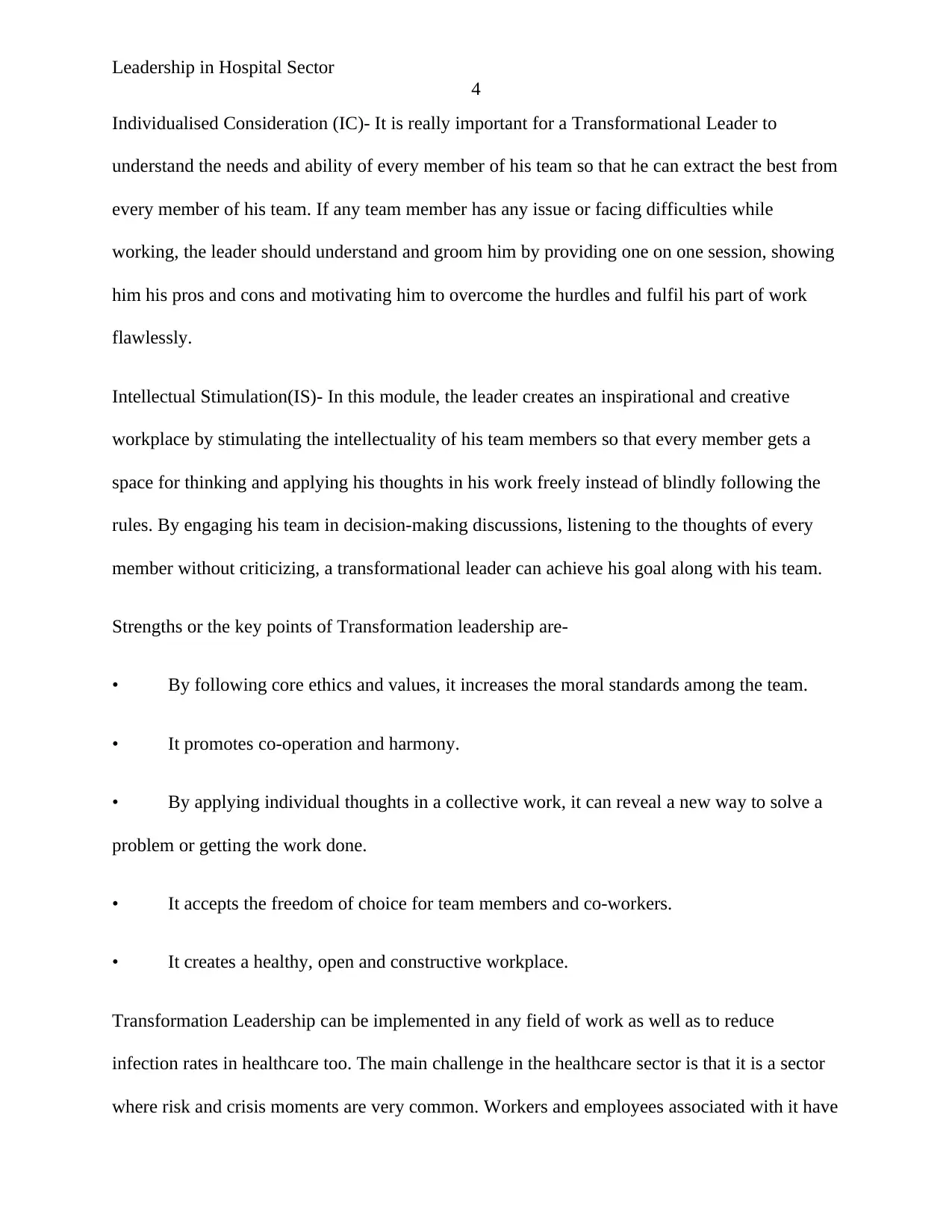
Leadership in Hospital Sector
4
Individualised Consideration (IC)- It is really important for a Transformational Leader to
understand the needs and ability of every member of his team so that he can extract the best from
every member of his team. If any team member has any issue or facing difficulties while
working, the leader should understand and groom him by providing one on one session, showing
him his pros and cons and motivating him to overcome the hurdles and fulfil his part of work
flawlessly.
Intellectual Stimulation(IS)- In this module, the leader creates an inspirational and creative
workplace by stimulating the intellectuality of his team members so that every member gets a
space for thinking and applying his thoughts in his work freely instead of blindly following the
rules. By engaging his team in decision-making discussions, listening to the thoughts of every
member without criticizing, a transformational leader can achieve his goal along with his team.
Strengths or the key points of Transformation leadership are-
• By following core ethics and values, it increases the moral standards among the team.
• It promotes co-operation and harmony.
• By applying individual thoughts in a collective work, it can reveal a new way to solve a
problem or getting the work done.
• It accepts the freedom of choice for team members and co-workers.
• It creates a healthy, open and constructive workplace.
Transformation Leadership can be implemented in any field of work as well as to reduce
infection rates in healthcare too. The main challenge in the healthcare sector is that it is a sector
where risk and crisis moments are very common. Workers and employees associated with it have
4
Individualised Consideration (IC)- It is really important for a Transformational Leader to
understand the needs and ability of every member of his team so that he can extract the best from
every member of his team. If any team member has any issue or facing difficulties while
working, the leader should understand and groom him by providing one on one session, showing
him his pros and cons and motivating him to overcome the hurdles and fulfil his part of work
flawlessly.
Intellectual Stimulation(IS)- In this module, the leader creates an inspirational and creative
workplace by stimulating the intellectuality of his team members so that every member gets a
space for thinking and applying his thoughts in his work freely instead of blindly following the
rules. By engaging his team in decision-making discussions, listening to the thoughts of every
member without criticizing, a transformational leader can achieve his goal along with his team.
Strengths or the key points of Transformation leadership are-
• By following core ethics and values, it increases the moral standards among the team.
• It promotes co-operation and harmony.
• By applying individual thoughts in a collective work, it can reveal a new way to solve a
problem or getting the work done.
• It accepts the freedom of choice for team members and co-workers.
• It creates a healthy, open and constructive workplace.
Transformation Leadership can be implemented in any field of work as well as to reduce
infection rates in healthcare too. The main challenge in the healthcare sector is that it is a sector
where risk and crisis moments are very common. Workers and employees associated with it have
Paraphrase This Document
Need a fresh take? Get an instant paraphrase of this document with our AI Paraphraser

Leadership in Hospital Sector
5
to take extra burden and responsibility. Here in this sector, the main consumers are the common
people, and everyone wants the best level of satisfaction and service. Getting affected by
Infections are very common, and it increases in some specific seasons. Sometimes, it gets worse
though by causing epidemic and can be the reason of death also. To wipe out or reduce the
infection rate in healthcare, transformation leadership can play a vital role. As working in the
healthcare sector is very critical, so having transformational leadership in this sector can be very
helpful to get a good and satisfactory result. The leader should encourage the team to work
better, make everyone understand that all are working with a common goal to reduce infections
which by itself is a noble cause and everyone including common people to the employees will
get benefited with it. Besides, it will help us to build a better future for us and our upcoming
generation. Besides, the leader should make a concrete roadmap to achieve his goal. And then he
has to make the whole team understand about it, inspires everyone to fight against infections give
their best to reduce it. He can also set a real-time based deadline. If any member having issues to
work or facing any difficulty, he can understand it and suggest him accordingly. Besides it, he
also should make a plan for unwanted situations, crisis moments as in the healthcare sector; these
are very common. He also can evaluate the performance of his team and every member on time
to time basis to improve their skill. If someone’s performance is getting down or if someone is
facing hurdles, he can provide him with a performance improvement plan so that the actual
mission does not get affected. Besides it, he can also think how advanced medical technology
can be used to reduce the infection rate. These are how Transformational Leadership can be
implemented in healthcare to reduce infection rates. According to David Greenfield, professor of
Center for medical power study in health, University of New South Wales, Sydney, Australia
and author of ‘The enactment of dynamic leadership: leadership in health services’, Leadership
5
to take extra burden and responsibility. Here in this sector, the main consumers are the common
people, and everyone wants the best level of satisfaction and service. Getting affected by
Infections are very common, and it increases in some specific seasons. Sometimes, it gets worse
though by causing epidemic and can be the reason of death also. To wipe out or reduce the
infection rate in healthcare, transformation leadership can play a vital role. As working in the
healthcare sector is very critical, so having transformational leadership in this sector can be very
helpful to get a good and satisfactory result. The leader should encourage the team to work
better, make everyone understand that all are working with a common goal to reduce infections
which by itself is a noble cause and everyone including common people to the employees will
get benefited with it. Besides, it will help us to build a better future for us and our upcoming
generation. Besides, the leader should make a concrete roadmap to achieve his goal. And then he
has to make the whole team understand about it, inspires everyone to fight against infections give
their best to reduce it. He can also set a real-time based deadline. If any member having issues to
work or facing any difficulty, he can understand it and suggest him accordingly. Besides it, he
also should make a plan for unwanted situations, crisis moments as in the healthcare sector; these
are very common. He also can evaluate the performance of his team and every member on time
to time basis to improve their skill. If someone’s performance is getting down or if someone is
facing hurdles, he can provide him with a performance improvement plan so that the actual
mission does not get affected. Besides it, he can also think how advanced medical technology
can be used to reduce the infection rate. These are how Transformational Leadership can be
implemented in healthcare to reduce infection rates. According to David Greenfield, professor of
Center for medical power study in health, University of New South Wales, Sydney, Australia
and author of ‘The enactment of dynamic leadership: leadership in health services’, Leadership
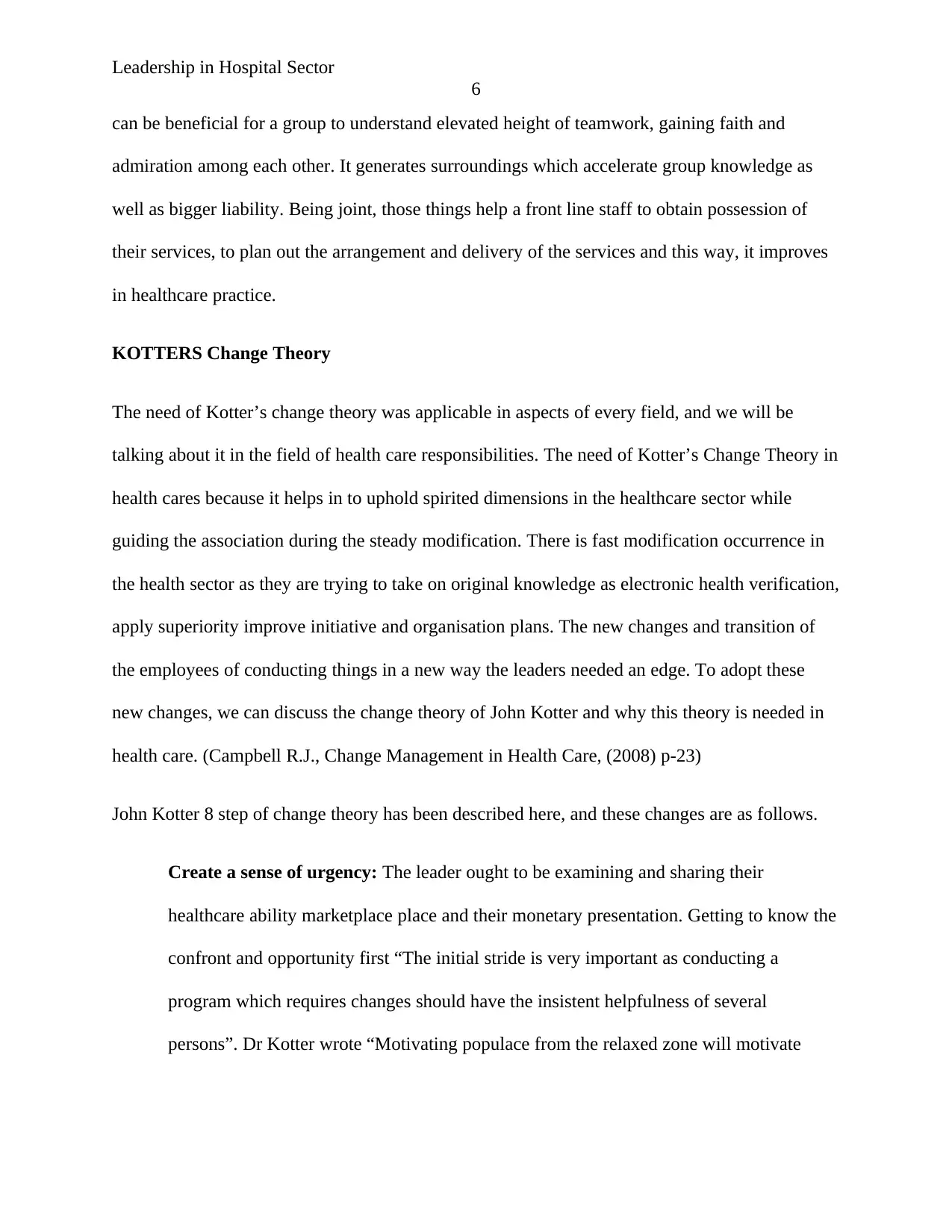
Leadership in Hospital Sector
6
can be beneficial for a group to understand elevated height of teamwork, gaining faith and
admiration among each other. It generates surroundings which accelerate group knowledge as
well as bigger liability. Being joint, those things help a front line staff to obtain possession of
their services, to plan out the arrangement and delivery of the services and this way, it improves
in healthcare practice.
KOTTERS Change Theory
The need of Kotter’s change theory was applicable in aspects of every field, and we will be
talking about it in the field of health care responsibilities. The need of Kotter’s Change Theory in
health cares because it helps in to uphold spirited dimensions in the healthcare sector while
guiding the association during the steady modification. There is fast modification occurrence in
the health sector as they are trying to take on original knowledge as electronic health verification,
apply superiority improve initiative and organisation plans. The new changes and transition of
the employees of conducting things in a new way the leaders needed an edge. To adopt these
new changes, we can discuss the change theory of John Kotter and why this theory is needed in
health care. (Campbell R.J., Change Management in Health Care, (2008) p-23)
John Kotter 8 step of change theory has been described here, and these changes are as follows.
Create a sense of urgency: The leader ought to be examining and sharing their
healthcare ability marketplace place and their monetary presentation. Getting to know the
confront and opportunity first “The initial stride is very important as conducting a
program which requires changes should have the insistent helpfulness of several
persons”. Dr Kotter wrote “Motivating populace from the relaxed zone will motivate
6
can be beneficial for a group to understand elevated height of teamwork, gaining faith and
admiration among each other. It generates surroundings which accelerate group knowledge as
well as bigger liability. Being joint, those things help a front line staff to obtain possession of
their services, to plan out the arrangement and delivery of the services and this way, it improves
in healthcare practice.
KOTTERS Change Theory
The need of Kotter’s change theory was applicable in aspects of every field, and we will be
talking about it in the field of health care responsibilities. The need of Kotter’s Change Theory in
health cares because it helps in to uphold spirited dimensions in the healthcare sector while
guiding the association during the steady modification. There is fast modification occurrence in
the health sector as they are trying to take on original knowledge as electronic health verification,
apply superiority improve initiative and organisation plans. The new changes and transition of
the employees of conducting things in a new way the leaders needed an edge. To adopt these
new changes, we can discuss the change theory of John Kotter and why this theory is needed in
health care. (Campbell R.J., Change Management in Health Care, (2008) p-23)
John Kotter 8 step of change theory has been described here, and these changes are as follows.
Create a sense of urgency: The leader ought to be examining and sharing their
healthcare ability marketplace place and their monetary presentation. Getting to know the
confront and opportunity first “The initial stride is very important as conducting a
program which requires changes should have the insistent helpfulness of several
persons”. Dr Kotter wrote “Motivating populace from the relaxed zone will motivate
⊘ This is a preview!⊘
Do you want full access?
Subscribe today to unlock all pages.

Trusted by 1+ million students worldwide
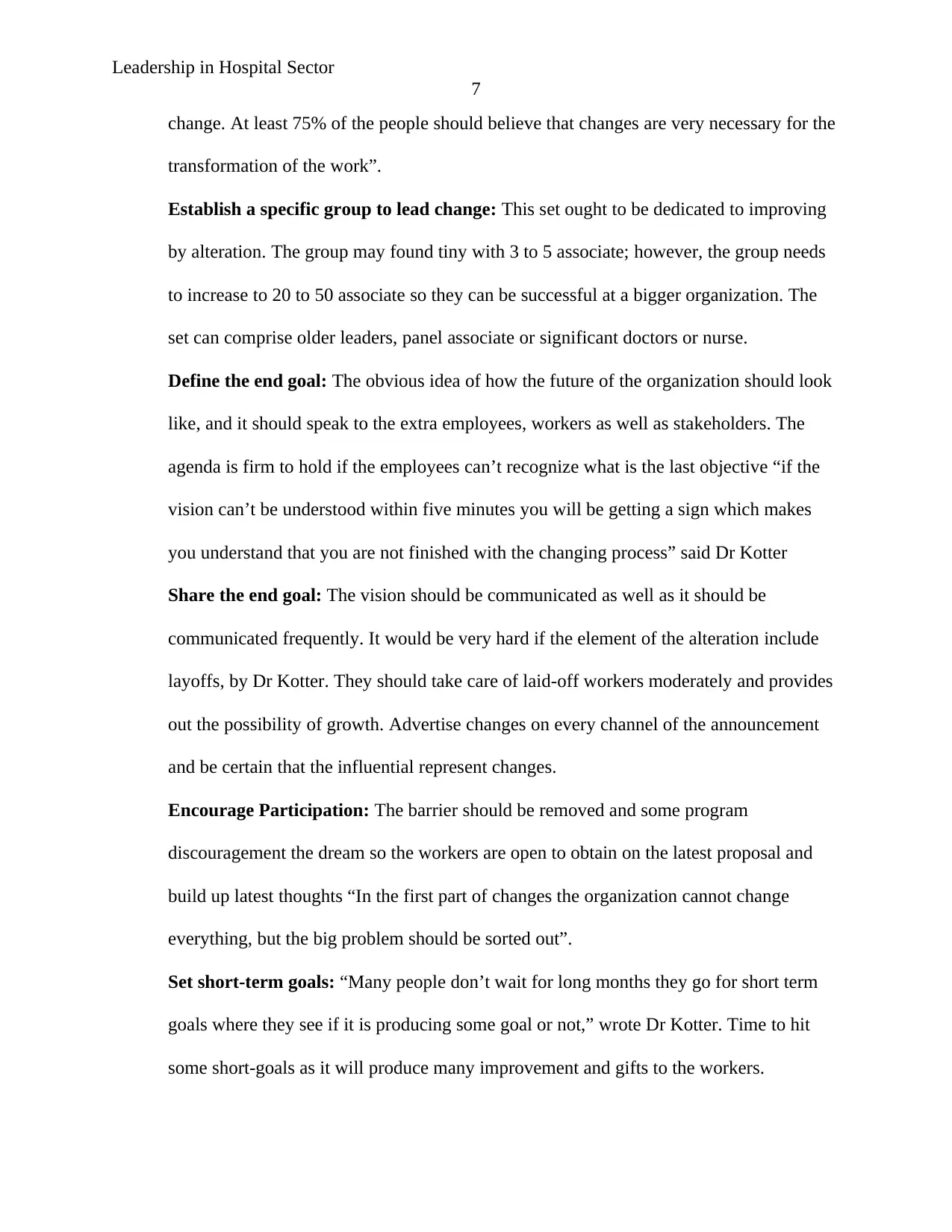
Leadership in Hospital Sector
7
change. At least 75% of the people should believe that changes are very necessary for the
transformation of the work”.
Establish a specific group to lead change: This set ought to be dedicated to improving
by alteration. The group may found tiny with 3 to 5 associate; however, the group needs
to increase to 20 to 50 associate so they can be successful at a bigger organization. The
set can comprise older leaders, panel associate or significant doctors or nurse.
Define the end goal: The obvious idea of how the future of the organization should look
like, and it should speak to the extra employees, workers as well as stakeholders. The
agenda is firm to hold if the employees can’t recognize what is the last objective “if the
vision can’t be understood within five minutes you will be getting a sign which makes
you understand that you are not finished with the changing process” said Dr Kotter
Share the end goal: The vision should be communicated as well as it should be
communicated frequently. It would be very hard if the element of the alteration include
layoffs, by Dr Kotter. They should take care of laid-off workers moderately and provides
out the possibility of growth. Advertise changes on every channel of the announcement
and be certain that the influential represent changes.
Encourage Participation: The barrier should be removed and some program
discouragement the dream so the workers are open to obtain on the latest proposal and
build up latest thoughts “In the first part of changes the organization cannot change
everything, but the big problem should be sorted out”.
Set short-term goals: “Many people don’t wait for long months they go for short term
goals where they see if it is producing some goal or not,” wrote Dr Kotter. Time to hit
some short-goals as it will produce many improvement and gifts to the workers.
7
change. At least 75% of the people should believe that changes are very necessary for the
transformation of the work”.
Establish a specific group to lead change: This set ought to be dedicated to improving
by alteration. The group may found tiny with 3 to 5 associate; however, the group needs
to increase to 20 to 50 associate so they can be successful at a bigger organization. The
set can comprise older leaders, panel associate or significant doctors or nurse.
Define the end goal: The obvious idea of how the future of the organization should look
like, and it should speak to the extra employees, workers as well as stakeholders. The
agenda is firm to hold if the employees can’t recognize what is the last objective “if the
vision can’t be understood within five minutes you will be getting a sign which makes
you understand that you are not finished with the changing process” said Dr Kotter
Share the end goal: The vision should be communicated as well as it should be
communicated frequently. It would be very hard if the element of the alteration include
layoffs, by Dr Kotter. They should take care of laid-off workers moderately and provides
out the possibility of growth. Advertise changes on every channel of the announcement
and be certain that the influential represent changes.
Encourage Participation: The barrier should be removed and some program
discouragement the dream so the workers are open to obtain on the latest proposal and
build up latest thoughts “In the first part of changes the organization cannot change
everything, but the big problem should be sorted out”.
Set short-term goals: “Many people don’t wait for long months they go for short term
goals where they see if it is producing some goal or not,” wrote Dr Kotter. Time to hit
some short-goals as it will produce many improvement and gifts to the workers.
Paraphrase This Document
Need a fresh take? Get an instant paraphrase of this document with our AI Paraphraser
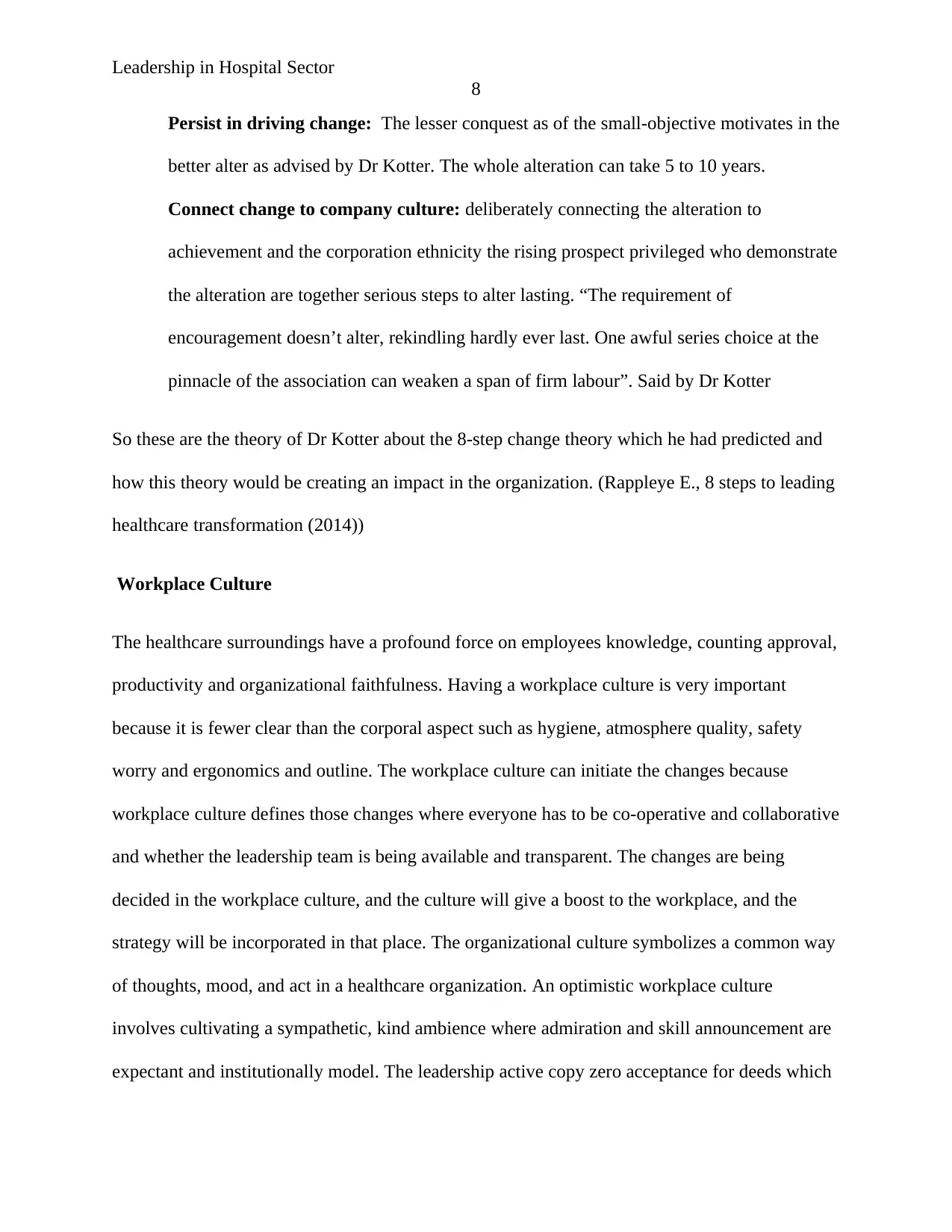
Leadership in Hospital Sector
8
Persist in driving change: The lesser conquest as of the small-objective motivates in the
better alter as advised by Dr Kotter. The whole alteration can take 5 to 10 years.
Connect change to company culture: deliberately connecting the alteration to
achievement and the corporation ethnicity the rising prospect privileged who demonstrate
the alteration are together serious steps to alter lasting. “The requirement of
encouragement doesn’t alter, rekindling hardly ever last. One awful series choice at the
pinnacle of the association can weaken a span of firm labour”. Said by Dr Kotter
So these are the theory of Dr Kotter about the 8-step change theory which he had predicted and
how this theory would be creating an impact in the organization. (Rappleye E., 8 steps to leading
healthcare transformation (2014))
Workplace Culture
The healthcare surroundings have a profound force on employees knowledge, counting approval,
productivity and organizational faithfulness. Having a workplace culture is very important
because it is fewer clear than the corporal aspect such as hygiene, atmosphere quality, safety
worry and ergonomics and outline. The workplace culture can initiate the changes because
workplace culture defines those changes where everyone has to be co-operative and collaborative
and whether the leadership team is being available and transparent. The changes are being
decided in the workplace culture, and the culture will give a boost to the workplace, and the
strategy will be incorporated in that place. The organizational culture symbolizes a common way
of thoughts, mood, and act in a healthcare organization. An optimistic workplace culture
involves cultivating a sympathetic, kind ambience where admiration and skill announcement are
expectant and institutionally model. The leadership active copy zero acceptance for deeds which
8
Persist in driving change: The lesser conquest as of the small-objective motivates in the
better alter as advised by Dr Kotter. The whole alteration can take 5 to 10 years.
Connect change to company culture: deliberately connecting the alteration to
achievement and the corporation ethnicity the rising prospect privileged who demonstrate
the alteration are together serious steps to alter lasting. “The requirement of
encouragement doesn’t alter, rekindling hardly ever last. One awful series choice at the
pinnacle of the association can weaken a span of firm labour”. Said by Dr Kotter
So these are the theory of Dr Kotter about the 8-step change theory which he had predicted and
how this theory would be creating an impact in the organization. (Rappleye E., 8 steps to leading
healthcare transformation (2014))
Workplace Culture
The healthcare surroundings have a profound force on employees knowledge, counting approval,
productivity and organizational faithfulness. Having a workplace culture is very important
because it is fewer clear than the corporal aspect such as hygiene, atmosphere quality, safety
worry and ergonomics and outline. The workplace culture can initiate the changes because
workplace culture defines those changes where everyone has to be co-operative and collaborative
and whether the leadership team is being available and transparent. The changes are being
decided in the workplace culture, and the culture will give a boost to the workplace, and the
strategy will be incorporated in that place. The organizational culture symbolizes a common way
of thoughts, mood, and act in a healthcare organization. An optimistic workplace culture
involves cultivating a sympathetic, kind ambience where admiration and skill announcement are
expectant and institutionally model. The leadership active copy zero acceptance for deeds which
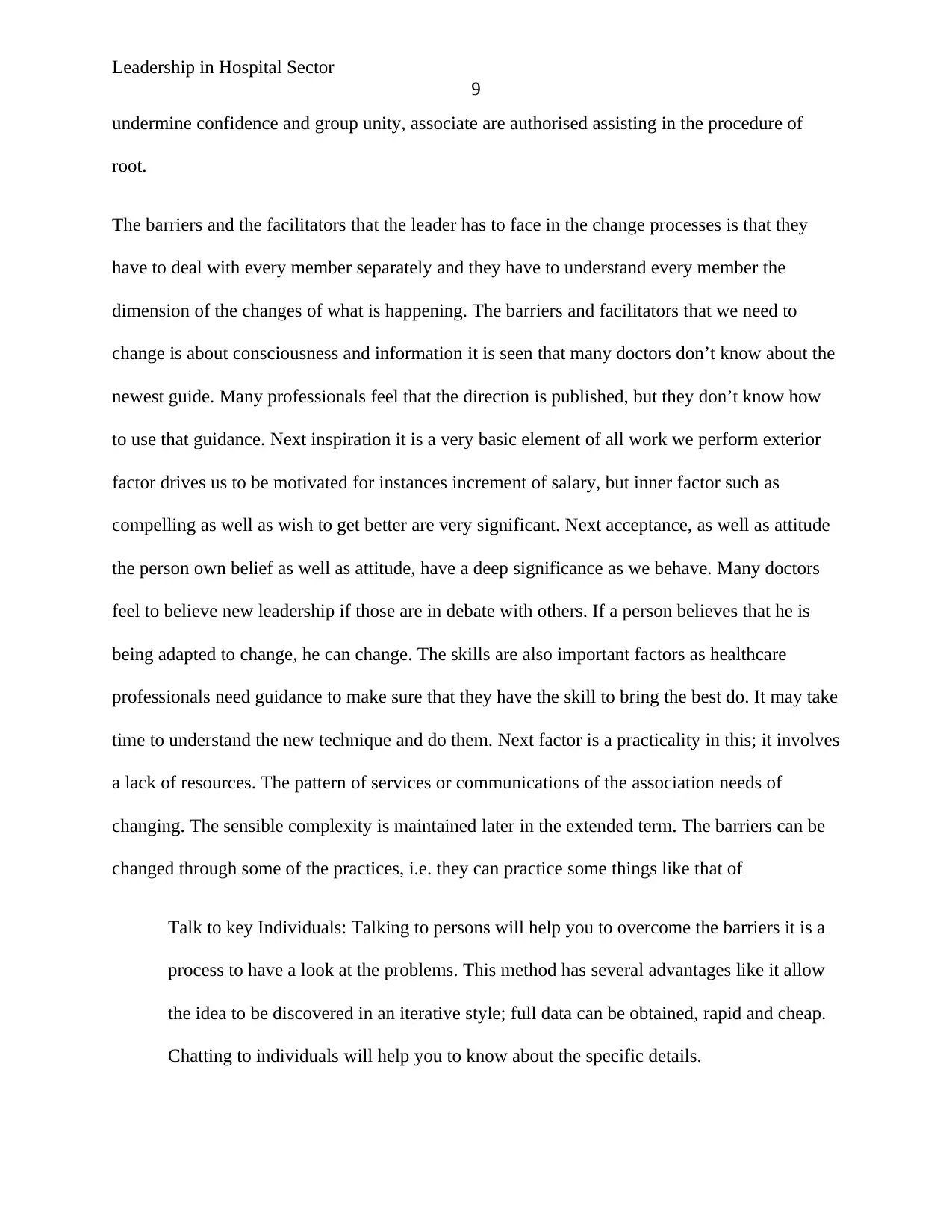
Leadership in Hospital Sector
9
undermine confidence and group unity, associate are authorised assisting in the procedure of
root.
The barriers and the facilitators that the leader has to face in the change processes is that they
have to deal with every member separately and they have to understand every member the
dimension of the changes of what is happening. The barriers and facilitators that we need to
change is about consciousness and information it is seen that many doctors don’t know about the
newest guide. Many professionals feel that the direction is published, but they don’t know how
to use that guidance. Next inspiration it is a very basic element of all work we perform exterior
factor drives us to be motivated for instances increment of salary, but inner factor such as
compelling as well as wish to get better are very significant. Next acceptance, as well as attitude
the person own belief as well as attitude, have a deep significance as we behave. Many doctors
feel to believe new leadership if those are in debate with others. If a person believes that he is
being adapted to change, he can change. The skills are also important factors as healthcare
professionals need guidance to make sure that they have the skill to bring the best do. It may take
time to understand the new technique and do them. Next factor is a practicality in this; it involves
a lack of resources. The pattern of services or communications of the association needs of
changing. The sensible complexity is maintained later in the extended term. The barriers can be
changed through some of the practices, i.e. they can practice some things like that of
Talk to key Individuals: Talking to persons will help you to overcome the barriers it is a
process to have a look at the problems. This method has several advantages like it allow
the idea to be discovered in an iterative style; full data can be obtained, rapid and cheap.
Chatting to individuals will help you to know about the specific details.
9
undermine confidence and group unity, associate are authorised assisting in the procedure of
root.
The barriers and the facilitators that the leader has to face in the change processes is that they
have to deal with every member separately and they have to understand every member the
dimension of the changes of what is happening. The barriers and facilitators that we need to
change is about consciousness and information it is seen that many doctors don’t know about the
newest guide. Many professionals feel that the direction is published, but they don’t know how
to use that guidance. Next inspiration it is a very basic element of all work we perform exterior
factor drives us to be motivated for instances increment of salary, but inner factor such as
compelling as well as wish to get better are very significant. Next acceptance, as well as attitude
the person own belief as well as attitude, have a deep significance as we behave. Many doctors
feel to believe new leadership if those are in debate with others. If a person believes that he is
being adapted to change, he can change. The skills are also important factors as healthcare
professionals need guidance to make sure that they have the skill to bring the best do. It may take
time to understand the new technique and do them. Next factor is a practicality in this; it involves
a lack of resources. The pattern of services or communications of the association needs of
changing. The sensible complexity is maintained later in the extended term. The barriers can be
changed through some of the practices, i.e. they can practice some things like that of
Talk to key Individuals: Talking to persons will help you to overcome the barriers it is a
process to have a look at the problems. This method has several advantages like it allow
the idea to be discovered in an iterative style; full data can be obtained, rapid and cheap.
Chatting to individuals will help you to know about the specific details.
⊘ This is a preview!⊘
Do you want full access?
Subscribe today to unlock all pages.

Trusted by 1+ million students worldwide
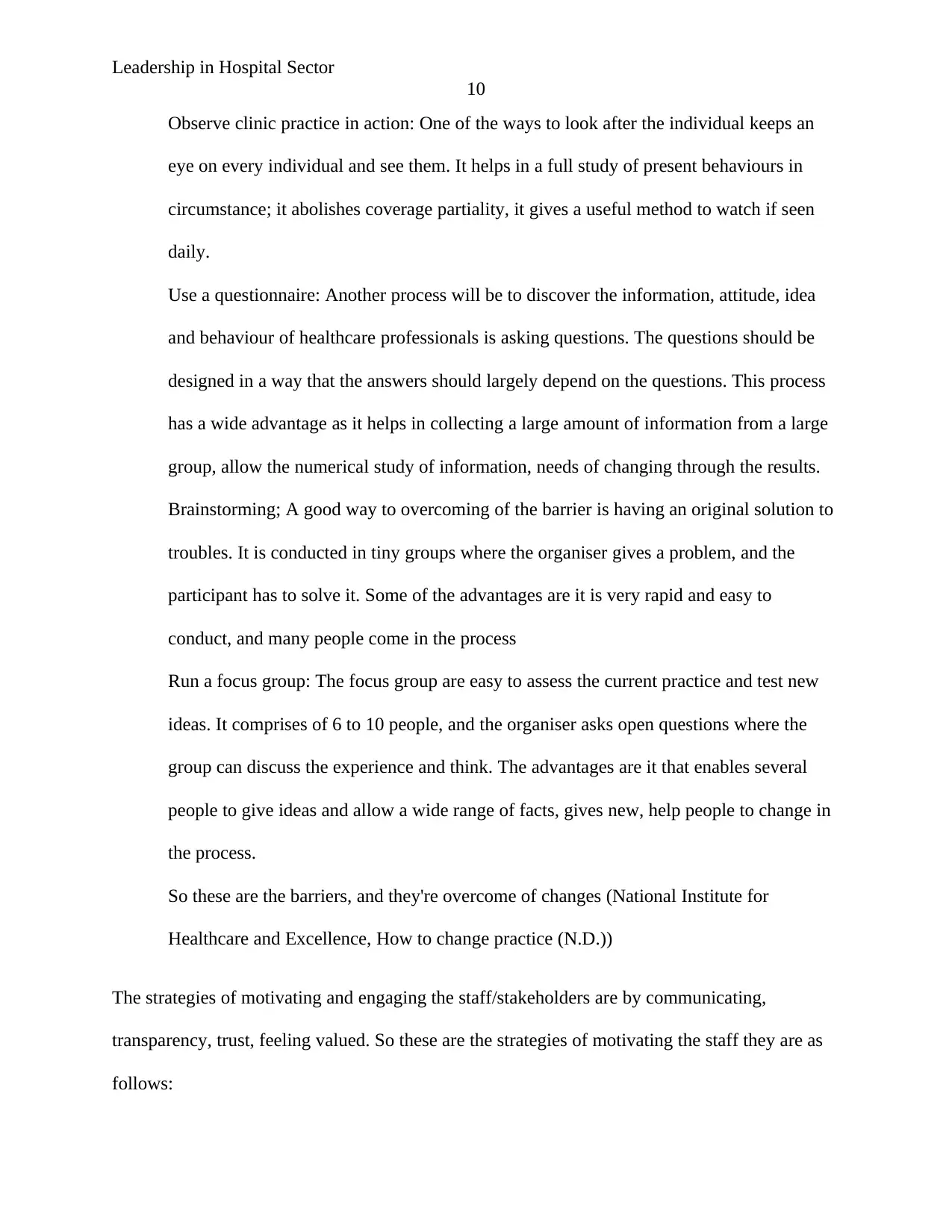
Leadership in Hospital Sector
10
Observe clinic practice in action: One of the ways to look after the individual keeps an
eye on every individual and see them. It helps in a full study of present behaviours in
circumstance; it abolishes coverage partiality, it gives a useful method to watch if seen
daily.
Use a questionnaire: Another process will be to discover the information, attitude, idea
and behaviour of healthcare professionals is asking questions. The questions should be
designed in a way that the answers should largely depend on the questions. This process
has a wide advantage as it helps in collecting a large amount of information from a large
group, allow the numerical study of information, needs of changing through the results.
Brainstorming; A good way to overcoming of the barrier is having an original solution to
troubles. It is conducted in tiny groups where the organiser gives a problem, and the
participant has to solve it. Some of the advantages are it is very rapid and easy to
conduct, and many people come in the process
Run a focus group: The focus group are easy to assess the current practice and test new
ideas. It comprises of 6 to 10 people, and the organiser asks open questions where the
group can discuss the experience and think. The advantages are it that enables several
people to give ideas and allow a wide range of facts, gives new, help people to change in
the process.
So these are the barriers, and they're overcome of changes (National Institute for
Healthcare and Excellence, How to change practice (N.D.))
The strategies of motivating and engaging the staff/stakeholders are by communicating,
transparency, trust, feeling valued. So these are the strategies of motivating the staff they are as
follows:
10
Observe clinic practice in action: One of the ways to look after the individual keeps an
eye on every individual and see them. It helps in a full study of present behaviours in
circumstance; it abolishes coverage partiality, it gives a useful method to watch if seen
daily.
Use a questionnaire: Another process will be to discover the information, attitude, idea
and behaviour of healthcare professionals is asking questions. The questions should be
designed in a way that the answers should largely depend on the questions. This process
has a wide advantage as it helps in collecting a large amount of information from a large
group, allow the numerical study of information, needs of changing through the results.
Brainstorming; A good way to overcoming of the barrier is having an original solution to
troubles. It is conducted in tiny groups where the organiser gives a problem, and the
participant has to solve it. Some of the advantages are it is very rapid and easy to
conduct, and many people come in the process
Run a focus group: The focus group are easy to assess the current practice and test new
ideas. It comprises of 6 to 10 people, and the organiser asks open questions where the
group can discuss the experience and think. The advantages are it that enables several
people to give ideas and allow a wide range of facts, gives new, help people to change in
the process.
So these are the barriers, and they're overcome of changes (National Institute for
Healthcare and Excellence, How to change practice (N.D.))
The strategies of motivating and engaging the staff/stakeholders are by communicating,
transparency, trust, feeling valued. So these are the strategies of motivating the staff they are as
follows:
Paraphrase This Document
Need a fresh take? Get an instant paraphrase of this document with our AI Paraphraser
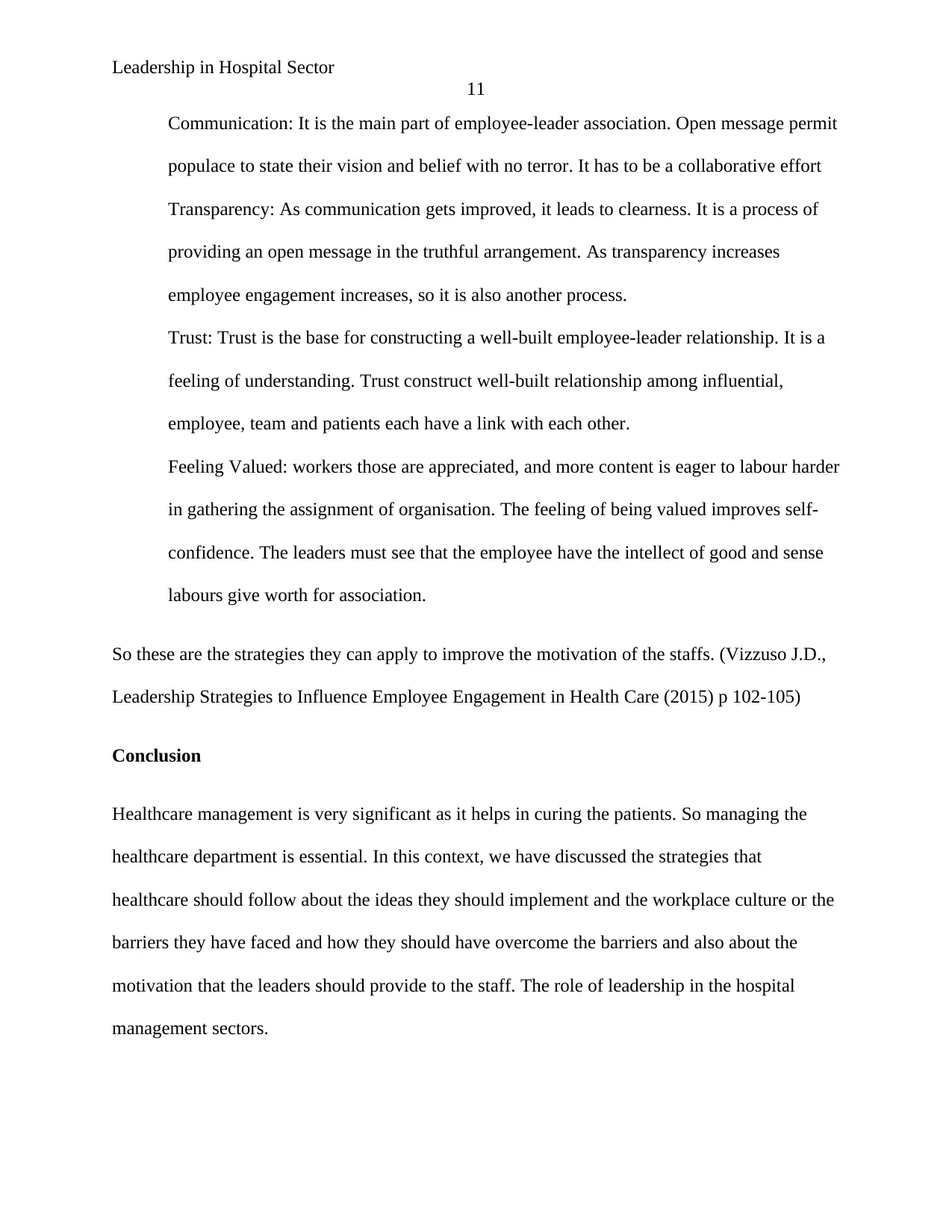
Leadership in Hospital Sector
11
Communication: It is the main part of employee-leader association. Open message permit
populace to state their vision and belief with no terror. It has to be a collaborative effort
Transparency: As communication gets improved, it leads to clearness. It is a process of
providing an open message in the truthful arrangement. As transparency increases
employee engagement increases, so it is also another process.
Trust: Trust is the base for constructing a well-built employee-leader relationship. It is a
feeling of understanding. Trust construct well-built relationship among influential,
employee, team and patients each have a link with each other.
Feeling Valued: workers those are appreciated, and more content is eager to labour harder
in gathering the assignment of organisation. The feeling of being valued improves self-
confidence. The leaders must see that the employee have the intellect of good and sense
labours give worth for association.
So these are the strategies they can apply to improve the motivation of the staffs. (Vizzuso J.D.,
Leadership Strategies to Influence Employee Engagement in Health Care (2015) p 102-105)
Conclusion
Healthcare management is very significant as it helps in curing the patients. So managing the
healthcare department is essential. In this context, we have discussed the strategies that
healthcare should follow about the ideas they should implement and the workplace culture or the
barriers they have faced and how they should have overcome the barriers and also about the
motivation that the leaders should provide to the staff. The role of leadership in the hospital
management sectors.
11
Communication: It is the main part of employee-leader association. Open message permit
populace to state their vision and belief with no terror. It has to be a collaborative effort
Transparency: As communication gets improved, it leads to clearness. It is a process of
providing an open message in the truthful arrangement. As transparency increases
employee engagement increases, so it is also another process.
Trust: Trust is the base for constructing a well-built employee-leader relationship. It is a
feeling of understanding. Trust construct well-built relationship among influential,
employee, team and patients each have a link with each other.
Feeling Valued: workers those are appreciated, and more content is eager to labour harder
in gathering the assignment of organisation. The feeling of being valued improves self-
confidence. The leaders must see that the employee have the intellect of good and sense
labours give worth for association.
So these are the strategies they can apply to improve the motivation of the staffs. (Vizzuso J.D.,
Leadership Strategies to Influence Employee Engagement in Health Care (2015) p 102-105)
Conclusion
Healthcare management is very significant as it helps in curing the patients. So managing the
healthcare department is essential. In this context, we have discussed the strategies that
healthcare should follow about the ideas they should implement and the workplace culture or the
barriers they have faced and how they should have overcome the barriers and also about the
motivation that the leaders should provide to the staff. The role of leadership in the hospital
management sectors.
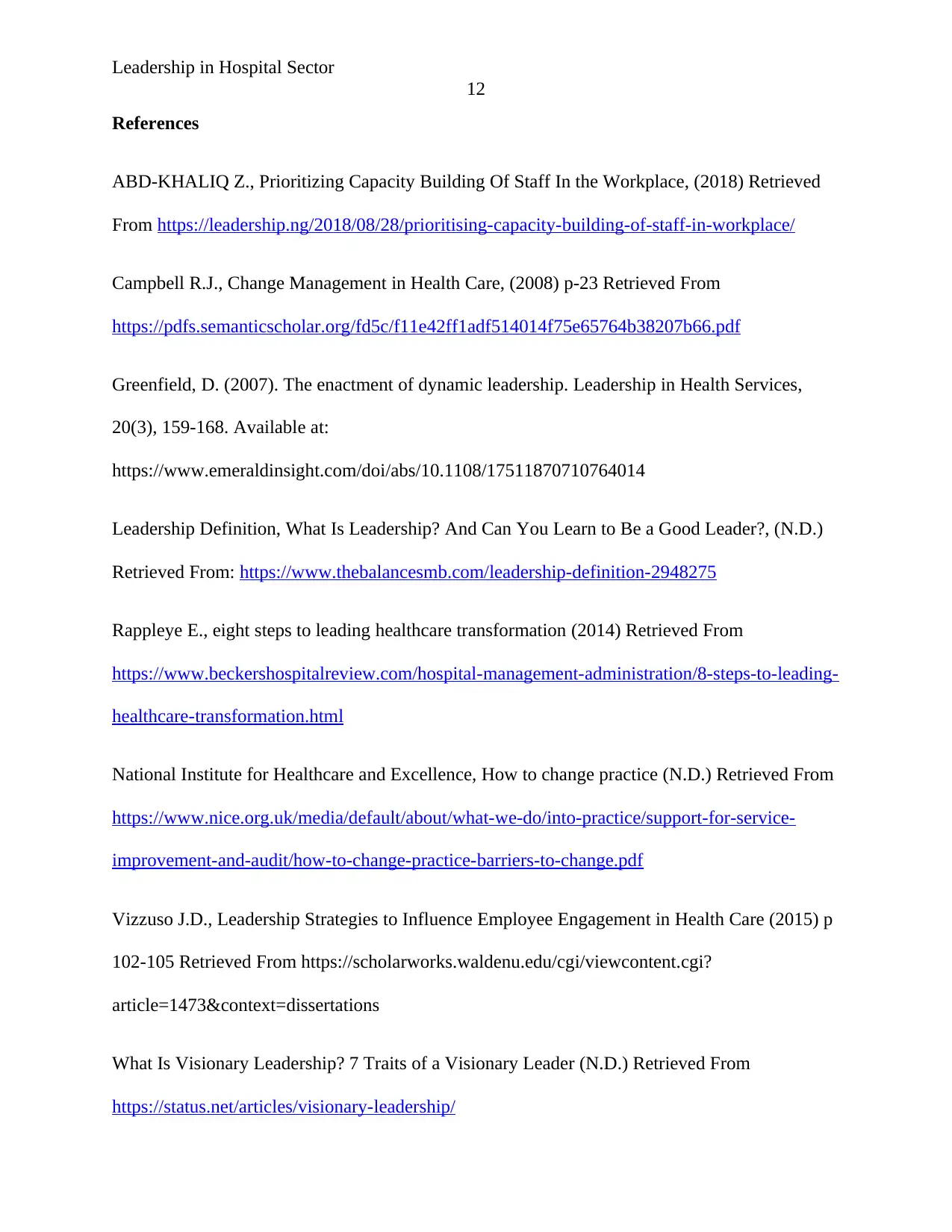
Leadership in Hospital Sector
12
References
ABD-KHALIQ Z., Prioritizing Capacity Building Of Staff In the Workplace, (2018) Retrieved
From https://leadership.ng/2018/08/28/prioritising-capacity-building-of-staff-in-workplace/
Campbell R.J., Change Management in Health Care, (2008) p-23 Retrieved From
https://pdfs.semanticscholar.org/fd5c/f11e42ff1adf514014f75e65764b38207b66.pdf
Greenfield, D. (2007). The enactment of dynamic leadership. Leadership in Health Services,
20(3), 159-168. Available at:
https://www.emeraldinsight.com/doi/abs/10.1108/17511870710764014
Leadership Definition, What Is Leadership? And Can You Learn to Be a Good Leader?, (N.D.)
Retrieved From: https://www.thebalancesmb.com/leadership-definition-2948275
Rappleye E., eight steps to leading healthcare transformation (2014) Retrieved From
https://www.beckershospitalreview.com/hospital-management-administration/8-steps-to-leading-
healthcare-transformation.html
National Institute for Healthcare and Excellence, How to change practice (N.D.) Retrieved From
https://www.nice.org.uk/media/default/about/what-we-do/into-practice/support-for-service-
improvement-and-audit/how-to-change-practice-barriers-to-change.pdf
Vizzuso J.D., Leadership Strategies to Influence Employee Engagement in Health Care (2015) p
102-105 Retrieved From https://scholarworks.waldenu.edu/cgi/viewcontent.cgi?
article=1473&context=dissertations
What Is Visionary Leadership? 7 Traits of a Visionary Leader (N.D.) Retrieved From
https://status.net/articles/visionary-leadership/
12
References
ABD-KHALIQ Z., Prioritizing Capacity Building Of Staff In the Workplace, (2018) Retrieved
From https://leadership.ng/2018/08/28/prioritising-capacity-building-of-staff-in-workplace/
Campbell R.J., Change Management in Health Care, (2008) p-23 Retrieved From
https://pdfs.semanticscholar.org/fd5c/f11e42ff1adf514014f75e65764b38207b66.pdf
Greenfield, D. (2007). The enactment of dynamic leadership. Leadership in Health Services,
20(3), 159-168. Available at:
https://www.emeraldinsight.com/doi/abs/10.1108/17511870710764014
Leadership Definition, What Is Leadership? And Can You Learn to Be a Good Leader?, (N.D.)
Retrieved From: https://www.thebalancesmb.com/leadership-definition-2948275
Rappleye E., eight steps to leading healthcare transformation (2014) Retrieved From
https://www.beckershospitalreview.com/hospital-management-administration/8-steps-to-leading-
healthcare-transformation.html
National Institute for Healthcare and Excellence, How to change practice (N.D.) Retrieved From
https://www.nice.org.uk/media/default/about/what-we-do/into-practice/support-for-service-
improvement-and-audit/how-to-change-practice-barriers-to-change.pdf
Vizzuso J.D., Leadership Strategies to Influence Employee Engagement in Health Care (2015) p
102-105 Retrieved From https://scholarworks.waldenu.edu/cgi/viewcontent.cgi?
article=1473&context=dissertations
What Is Visionary Leadership? 7 Traits of a Visionary Leader (N.D.) Retrieved From
https://status.net/articles/visionary-leadership/
⊘ This is a preview!⊘
Do you want full access?
Subscribe today to unlock all pages.

Trusted by 1+ million students worldwide
1 out of 13
Related Documents
Your All-in-One AI-Powered Toolkit for Academic Success.
+13062052269
info@desklib.com
Available 24*7 on WhatsApp / Email
![[object Object]](/_next/static/media/star-bottom.7253800d.svg)
Unlock your academic potential
Copyright © 2020–2025 A2Z Services. All Rights Reserved. Developed and managed by ZUCOL.





